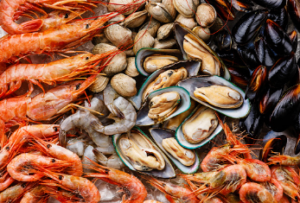Frozen seafood can be an economical and nutritious way to reduce food waste at home. Flash freezing helps preserve its nutritional value while helping prevent wasteful packaging practices.
Consider securely sealed packages free from ice crystals or dry, papery edges; avoid fish that has defrosted in its store case or showing signs of freezer burn.
Freshness
 Seafood should be frozen as soon as it has been harvested to preserve its nutrients, unlike fresh fish, which is susceptible to losing some vital elements due to air and light exposure. When stored at room temperature for months without losing flavour or texture, stocking your freezer with various meals is simple and cost-efficient!
Seafood should be frozen as soon as it has been harvested to preserve its nutrients, unlike fresh fish, which is susceptible to losing some vital elements due to air and light exposure. When stored at room temperature for months without losing flavour or texture, stocking your freezer with various meals is simple and cost-efficient!
Frozen seafood can be as nutritious and delectable as its fresh counterpart, thanks to modern freezing techniques. New methods of flash-freezing preserve seafood immediately after it has been caught, thus ensuring that a salmon fillet that was frozen while still on board can arrive on your dinner table with all its tenderness intact, just as deliciously tender and succulent flavour as one caught and sold that same day.
When purchasing frozen seafood, it’s essential that you only select high-quality products. Look for solidly frozen pieces with minimal surface ice crystals before rinsing and patting them dry with paper towels before cooking them.
Variety
Frozen seafood offers chefs and consumers a wide variety of products for chefs and consumers to select from. Some companies even provide value-added forms like breaded or battered seafood or complete dinners to give restaurants flexibility in tailoring menus for seasonal products that may not be readily available fresh. Furthermore, this variety allows restaurants to use less food waste through targeted menu selections highlighting seasonal products and reducing food waste.
The global frozen fish market is experiencing explosive growth, driven by increasing consumer interest in healthful foods and an increase in chemical-free fish with longer shelf lives. This trend is projected to continue through 2033 as people become more health-conscious and seek seafood as an essential source of nutrition. Furthermore, it is being propelled forward by large-scale consumption trends like fish farming, resulting in greater production capacities for farmers.
When shopping for frozen seafood, look for securely sealed packages with an expiration date printed on their labels. When purchasing live crabs and lobsters, be sure that there is some leg movement, as these species quickly spoil after death. Frozen food may spoil quickly if left at warm temperatures or thawing during storage; many manufacturers use time/temperature indicators on packaging to help you monitor this; also, remember to read any labels to ensure it has not been stored too long.
Value
Seafood is packed with essential nutrients such as proteins, healthy fats (polyunsaturated fatty acids, omega-3 and omega-6), iodine, vitamin D and calcium – making it a delicious source of nutrition that may reduce heart diseases, autoimmune disorders and inflammation in the body. Because of this nutritional profile of seafood, consumers love this delicacy!
The global frozen seafood market is anticipated to reach US$ 48 billion by 2033, driven by global consumer appetite for convenient food products and increasing global demand. Leading frozen seafood manufacturers are developing products that combine taste and convenience for customer needs, creating new product lines based on guest favourites’ crave-able dishes like Red Lobster’s iconic dishes, as well as offering them as guests’ favourite choices (in February 2023, Red Lobster introduced their first range of frozen shrimp products based off its most-requested dishes).
Comparatively speaking, frozen food is less costly due to not having to be sold within an accelerated timeline and stored over an extended period without losing flavour and nutritional value.
Frozen seafood is typically sold through supermarkets and hypermarkets, constituting a substantial share of the overall market due to its widespread availability and purchase convenience, furthermore, due to urbanisation trends such as rising working population numbers and increased retail store penetration. Moreover, refrigeration technologies have provided further opportunities for storing and transporting these food items, further propelling its market.
Cooking
Seafood that has been frozen can taste just as great, if not even better, than fresh food. Flash freezing allows the seafood to be preserved at lower temperatures while cutting energy consumption and the carbon footprint associated with production, providing consumers with access to delicious seafood all year long and not just during seasons when supplies are plentiful. It represents a tremendous win for sustainability while giving people access to tasty treats anytime!
Cooking frozen seafood is as straightforward and tasty as its fresh counterpart, often yielding superior results. Here’s the process for frozen seafood preparation: